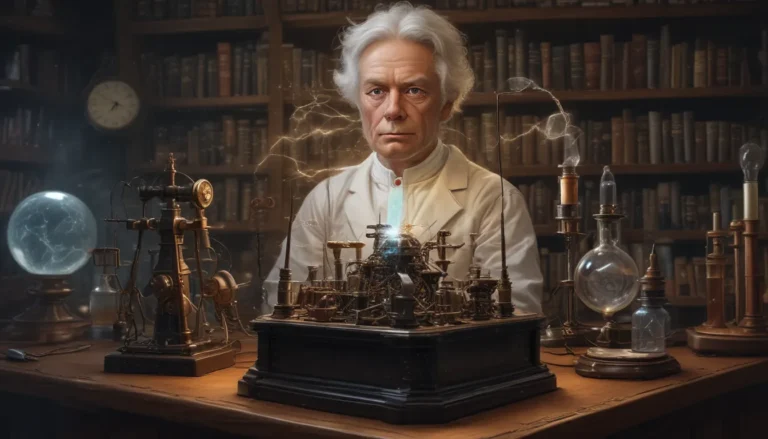A Note About Images: The images used in our articles are for illustration purposes only and may not exactly match the content. They are meant to engage readers, but the text should be relied upon for accurate information.
The Biot-Savart Law is a fundamental principle in physics that unlocks the mysteries of magnetic fields generated by electric currents. Named after the French physicists Jean-Baptiste Biot and Félix Savart, this law has profound implications in various fields such as electromagnetism, magnetostatics, and even astrophysics. Let’s embark on a captivating journey to explore 12 extraordinary facts about the Biot-Savart Law, delving into its history, mathematical representation, and practical applications.
Understanding the Biot-Savart Law
The Biot-Savart Law serves as a cornerstone in electromagnetic theory, offering a mathematical framework for calculating the magnetic field produced by a small section of current-carrying wire. This law underpins essential concepts in electromagnetism, including Ampere’s law and the principles of inductance, shaping our understanding of magnetic phenomena.
Deciphering the Role of Electric Current
At the core of the Biot-Savart Law lies the concept of electric current. This law dictates that the magnetic field created at a specific point in space is directly proportional to the current’s magnitude flowing through the wire and inversely proportional to the square of the distance from the wire. Understanding this relationship is key to unraveling the secrets of magnetic fields.
- Electric current is the driving force behind the creation of magnetic fields.
- The intensity of the magnetic field decreases as the distance from the wire increases.
The Universal Applicability of the Law
One remarkable aspect of the Biot-Savart Law is its universal applicability to all configurations of current-carrying wires, be it straight or curved, infinite or finite in length. This versatility empowers physicists and engineers to analyze complex systems and gain profound insights into the behavior of magnetic fields in diverse setups.
Revealing the Magnetic Field Direction
According to the Biot-Savart Law, the direction of the magnetic field produced by a current-carrying wire is contingent upon the current’s orientation. The field manifests as concentric circles around the wire, with the clockwise or counterclockwise rotation determined by the current flow’s direction.
- The magnetic field forms circular patterns around the current-carrying wire.
- The direction of the current dictates the orientation of the magnetic field.
Unveiling the Superposition Principle
In adherence to the principle of superposition, the Biot-Savart Law enables scientists to determine the total magnetic field at a particular point resulting from multiple current segments by summing their individual contributions. This principle facilitates the analysis of intricate systems featuring multiple currents, unraveling the complexities of magnetic interactions.
Insights into Solenoids and Ampere’s Circuital Law
By applying the Biot-Savart Law, physicists can delve into the magnetic field generated by a current-carrying solenoid, providing valuable insights into devices like transformers and inductors. Moreover, this law forms the theoretical groundwork for Ampere’s Circuital Law, establishing a profound link between current, magnetic fields, and their interplay in physical systems.
Navigating through Complex Geometries
When confronted with intricate geometries of current-carrying wires, the Biot-Savart Law reveals its elegance and complexity. Leveraging calculus and integration techniques, physicists and engineers can extend the law’s application to analyze convoluted systems, including curved wires and three-dimensional configurations.
- Calculus plays a pivotal role in extending the applicability of the Biot-Savart Law.
- Integration techniques enable the analysis of complex current distributions.
Examining the Magnetic Field around a Straight Wire
Analyzing a straight wire carrying current using the Biot-Savart Law unveils intriguing insights into the magnetic field’s behavior. The field manifests as circular patterns perpendicular to the wire, with its strength diminishing as the distance from the wire increases.
Unraveling Continuous Current Distributions
The Biot-Savart Law’s versatility extends to analyzing systems featuring continuous current distributions, such as uniform current density flowing through a slender wire. This application showcases the law’s prowess in handling diverse scenarios and shedding light on the magnetic fields generated by such distributions.
Embracing Contributions to Inductance
Inductance, a pivotal property in electrical circuits, relies on principles governed by the Biot-Savart Law. Inductors, designed to store energy in magnetic fields, leverage this law to establish the relationship between current flow in a wire coil and induced magnetic flux, shaping the foundation of electromagnetic devices.
Realizing Practical Applications of the Law
Beyond theoretical physics, the Biot-Savart Law finds practical applications across various fields. Engineers harness this law to analyze magnetic field behaviors in transformers, motors, generators, and a myriad of electromagnetic devices powering our modern world. The applicability and versatility of the law underscore its enduring relevance in contemporary technological advancements.
Conclusion: Unraveling the Mysteries of Magnetism
In conclusion, the Biot-Savart Law stands as a profound concept underpinning our understanding of magnetic phenomena induced by electric currents. From its historical origins to its practical applications in modern technology, this law continues to captivate researchers, engineers, and physicists worldwide. By delving into the intricate details of the Biot-Savart Law, we gain deeper insights into the fundamental principles governing magnetic fields, enriching our knowledge of electromagnetism.
FAQs
-
What is the Biot-Savart Law?
The Biot-Savart Law is a fundamental principle in physics that describes the magnetic field generated by a current-carrying wire. -
Who discovered the Biot-Savart Law?
The law was discovered by French physicists Jean-Baptiste Biot and Félix Savart in the early 19th century. -
What does the Biot-Savart Law state?
The law states that the magnetic field at any point in space is directly proportional to the current flowing through a small wire segment and inversely proportional to the distance from that segment. -
Is the Biot-Savart Law applicable to all shapes of current-carrying wires?
Yes, the law is universally applicable to any configuration of current-carrying wires, showcasing its versatility in analyzing magnetic fields. -
What are some practical applications of the Biot-Savart Law?
The Biot-Savart Law underpins various electromagnetic phenomena and devices, offering insights into transformers, motors, generators, and other technologies reliant on magnetic fields. -
Why is understanding the Biot-Savart Law important?
Comprehending the Biot-Savart Law is paramount for deciphering magnetic field behaviors and their impacts on electrical currents. This knowledge enables the insightful analysis and prediction of magnetic phenomena in diverse physical systems.






